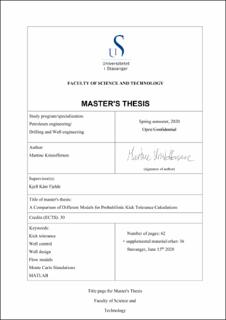| dc.description.abstract | Kick tolerance is an evaluation of how large kick sizes an open hole section can withstand without threatening the formation integrity at the shoe. If a certain kick size cannot be handled safely, the planned open hole section needs to be shortened, and the casing design has to be altered.
Three different flow models were used to simulate a kick situation: single bubble, transient flow, and analytical. The single bubble model and the transient flow model, based on the drift flux model, describe the kick circulation in time while the analytical model is a static model where the kick is situated at the bottom. These are all based on gas kicks in water-based mud. The simulations were performed with MATLAB, and to generate the different results, length and size of the open hole, BHA length and kick size are varied.
First, a transient model based on the single bubble concept was considered, and a Monte Carlo simulation framework was implemented. This modification was done along with extensive coding in order to further develop the previously written code. The purpose of the simulations was to see what kick location would give the largest casing shoe pressure: kick at bottom hole assembly (BHA) or kick expanding whilst travelling upwards towards the shoe. The results showed that in most cases, the maximum casing shoe pressure would occur when kick is located at the BHA. However, when simulations were performed with a long hole section, short BHA and large kick volume, gas expansion caused the maximum casing shoe pressure.
Secondly, the three models were simulated, and results were compared. The output was the fracture pressure and casing shoe pressure in the form of distributions. From the many Monte Carlo simulations of each case, the result was a failure probability based on the number of counts where the casing shoe pressure exceeded the fracture pressure at the shoe. The main objective of these simulations was to see how the three models compared by looking at the failure probabilities.
When comparing the models, the results show that the single bubble model provides the most conservative results and the transient flow model the least conservative. It would be reasonable to first calculate the casing shoe pressure to identify kick location at maximum pressure. Then, if the maximum pressure is caused by gas expansion, a transient model should be used to account for this. If not, the analytical model could be deemed appropriate. When calculating failure probability, the single bubble model might be too conservative due to the fact that it assumes the gas kick to be a single slug. | en_US |

